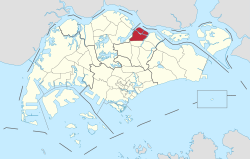Seletar
Seletar | |
|---|---|
| Other transcription(s) | |
| •Malay | Seletar(Rumi) سلتار(Jawi) |
| •Chinese | Thật lí đạt(Simplified) Thật lí đạt(Traditional) Shílǐdá(Pinyin) Si̍t-lí-ta̍t(HokkienPOJ) |
| •Tamil | சிலேத்தார் Cilēttār(Transliteration) |
 Location of Seletar in Singapore | |
| Coordinates:1°24′19.2″N103°51′58.6″E/ 1.405333°N 103.866278°E | |
| Country | |
| Region | North-East Region
|
| CDC | |
| Town council |
|
| Constituency | |
| Government | |
| • Mayor | Central Singapore CDC
|
| • Members of Parliament | Ang Mo Kio GRC |
| Area | |
| • Total | 10.25 km2(3.96 sq mi) |
| • Residential | 7.23 km2(2.79 sq mi) |
| Population | |
| • Total | 250 |
| • Density | 24/km2(63/sq mi) |
| Demonym | Official
|
| Postal district | 28 |
Seletar/səˈliːtɑːr/is an area located in the north-east of Singapore. Its name can also refer to theSeletar Planning Area(as defined by theUrban Redevelopment Authority), situated in theNorth-East Regionof Singapore. The place name was derived from the Malay subgroup who were indigenous to the area, theOrang Seletar.It shares boundaries with the planning areas ofSengkangto the south,Punggolto the east,YishunandSimpangto the west, as well as theStraits of Johorto the north.
Formerly Royal Air Force Station SeletarRoyal Air Forcemilitary airfieldsite, the area now houses a newS$60 millionSeletar Aerospace Parkthat spans 140 hectares. Theaerospacepark houses industries specialising inaircraft maintenanceand repair services.[3][4]There are future plans to transform Seletar into one of the Singapore's regional centres, along withJurong East,TampinesandWoodlands.Once the transformation is complete, Seletar will be known as the only regional centre without a single MRT line passing through it, unlike its other regional rivals who have multiple MRT lines. The recent introduction of newer residential property and retail malls, most notably Greenwich V and Seletar Mall,[5]Parc Botannia at Fernvale, Luxus Hill, Belgravia Ace[6]and Parc Greenwich has served well in rejuvenating the Seletar area, with further plans to increase BTO flats supply in the area serve to create additional housing options for people working in the Aerospace Park.
Geography[edit]
Geographical extent[edit]
According to the bookDown the Seletar River: Discovering a Hidden Treasure of Singapore,Seletar generally refers to a region defined by thePonggol Riverto the east, theSeletar Riverto the west,Ang Mo Kioto the south and theStraits of Johoreto the north. It includes the areas coveringYio Chu Kang,Jalan Kayu,Lower Seletar Reservoirand a part ofUpper Thomson.[7]
Seletar Planning Area[edit]
Seletar Planning Area, as defined by theUrban Redevelopment Authority,shares a land boundary with planning areas ofSengkangto the south, riverine boundaries withPunggolto the east andYishunto the west. Its northern boundary is made up by theStraits of Johor.[8][9]Seletar Planning Area is officially divided into 4 subzones – Seletar, Seletar Aerospace Park, Pulau Punggol Barat and Pulau Punggol Timor.
History[edit]
The area was home to the indigenousMalaypopulation, especially theOrang Seletar(Malay forSeletar people) - a subgroup ofMalay sea gypsiesliving on the waters of the island. There were already hundreds of them even before the arrival of Raffles. Seletar was originally a rubber plantation estate owned and managed by the Singapore United Rubber Plantations Ltd. In 1923, the Straits Settlement government bought 600 acres (2.4 km2) from the Singapore United Rubber Plantations Ltd and gave it to the BritishRoyal Air Forceas a site for its military air base in Singapore.[10]Construction of the airfield was completed in 1929 and it was officially opened in 1930. The airfield was the first RAF base east of India and had also served as a civilian airport until 1937, whenKallang Airportwas opened to the public.[11]
The Seletar Reservoir (now known asUpper Seletar Reservoir), was first built in 1920, after the First World War to cope with the water demand in Singapore. It was marked as a conservation site in August 1999.[12]
The area is also dotted with colonial bungalows that were built for the military personnel of the RAF, which still stands today. In 2007, the government announced that some 174 bungalows has been set aside for demolition to make way for the new Seletar Aerospace Park, while the remaining 204 bungalows will be retained and some of these units will be converted into aerospace training schools and food and beverage outlets, while 131 units will be set aside for residential use.[13]
See also[edit]
References[edit]
- ^abCity Population – statistics, maps and charts | Seletar
- ^"Statistics Singapore - Geographic Distribution - 2018 Latest Data".Retrieved11 February2019.
- ^Kaur, Karamjit (19 June 2007). "Plans for $60m Seletar Aerospace Park on course".The Straits Times.
- ^Kaur, Karamjit (27 June 2007). "Seletar gets ready for makeover as aerospace hub".The Straits Times.
- ^Greenwich V Mall (17 December 2021)."Retail and dining at Greenwich V."Greenwich V.
- ^Belgravia Ace (16 December 2021)."2021's newest collection of strata landed houses at Belgravia Drive".Belgravia Ace.
- ^Wijeysingha, Eugene (1 January 2013).Down the Seletar River: Discovering a Hidden Treasure of Singapore.Seletar Hills Estate Residents' Assoc.ISBN9789710579204.
- ^"URA SPACE".Urban Redevelopment Authority.
- ^"Planning Areas/Subzones in Singapore (Year 2015)"(PDF).Singapore Department of Statistics.Archived fromthe original(PDF)on 5 March 2016.Retrieved12 June2016.
- ^"Conservation Portal – History of Seletar".URA Singapore.Retrieved14 August2016.
- ^"Seletar Airport".Infopedia Singapore (National Library Board). Archived fromthe originalon 19 September 2016.Retrieved14 August2016.
- ^"Seletar Reservoir".Infopedia Singapore (National Library Board).Retrieved14 August2016.
- ^"The Colonial Bungalows of Seletar".The Lion Raw. 14 February 2014.Retrieved14 August2016.
Sources[edit]
- Victor R Savage, Brenda S A Yeoh (2003),Toponymics – A Study of Singapore Street Names,Eastern Universities Press,ISBN981-210-205-1

